Traditional Clothing of Iran
Traditional clothing perfectly reflects the history and costume of a nation.
It is not only a means to cover the body, but it has also always represented an idea about the person wearing it; who they are, what they do and where they come from. It also symbolizes and portrays their culture and belief.
Iran is the cradle of civilization and art, and the Iranian people protect their traditional heritage. As a country with Snowy Mountain tops, deserts, humid seasides, oak forests, romantic gardens, long rivers, and vast fields, Iran has allowed its people to experience diversity in every form and shape.
Although most Iranians are Persians, Iran is still a multi-ethnic and multicultural society with a varied population dispersed in different parts of Iran. From north to south and from east to west of Iran, each ethnic group has their unique languages, traditions and clothing style.
Iran's Traditional and Local Clothing
Iranian traditional clothing styles have extraordinary elegance and designs. Traditional Iranian clothing includes footwear, pants or socks, skirts with farthingale, top clothing, dress, waist scarf, cap, hats, kerchiefs and ornamental pendants, which all are beautifully put together and designed with bright and cheerful colours.
Travelling to Iran presents you with a wide range of traditional clothes belonging to different cities or cultures to show the glorious Persian heritage and its prodigious beauty that will penetrate your soul. Let's have a review of Iranian clothes to immerse in the fantastic beauty of dressing in Iran:
1. Kurdish Traditional Dress
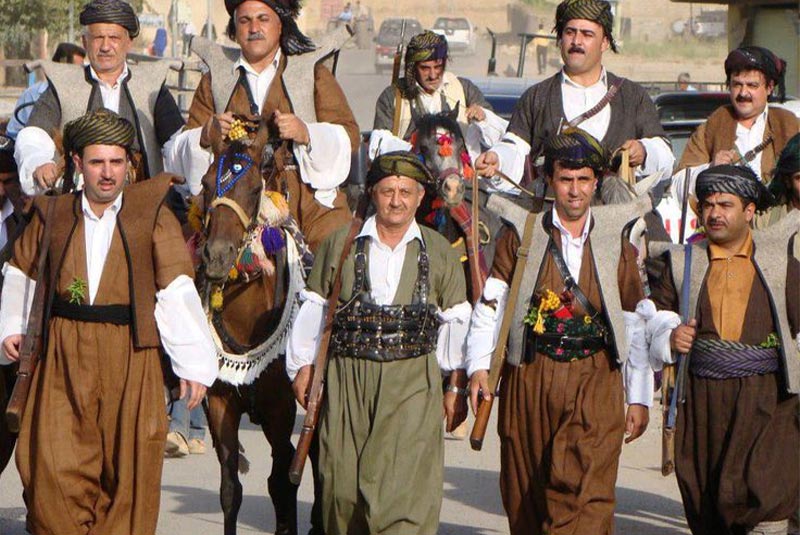
Kurdistan is a geo-cultural region spread across vast parts of Syria, Turkey, Iraq and Iran.
In Kurdistan, everything is based on nature, culture, occupation, music, and traditional clothing. Kurds like to wear their best traditional clothes in their ceremonies, especially the ancient ceremony 'Nowrooz ', New Year's eve. Kurdistan traditional clothing is one of the unique conventional clothing in Iran that dates back to ancient times. Kurdish traditional dress is mainly made of silk, velvet, and satin, decorated with sequins, stone, tapestry, and beads.
Kurdish men's clothing is often loose and baggy, making it easy to walk through mountains and challenging routes. They also wear matching clothes. They like to wear their loose pants in an identical colour to their coats and a special belt. The women wear headscarves decorated with dangling coins and jewels. They also wear long dresses with sequins, silver or gold ornaments, and a headband on their scarf.
Kurdistan men and women sometimes wear a black velvet hat adorned with amber and turquoise beads or gold and silver charms.
| Discover: Sama Dance | A Spiritual Journey in Persian Culture
2. Bakhtiari Traditional Dress
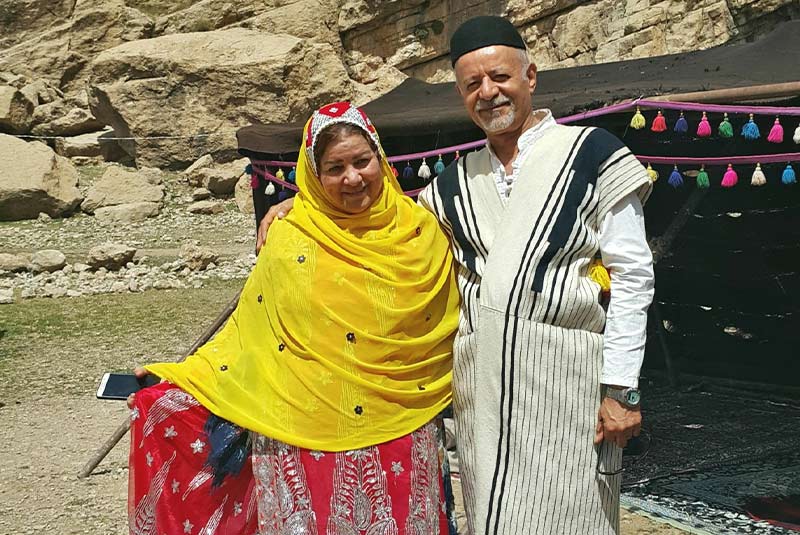
The Bakhtiari tribe are the largest tribe among the nomad tribes that live in Iran. They live and migrate yearly between five states in the southwest of Iran from the mountainous Chahar Mahal to the grassy plateau of the Khuzestan region. Hence their traditional dress is versatile by design and has been made to acclimate to the extreme weather conditions they may encounter during the migration. Bakhtiari men wear dark, loose trousers that are cut very wide and fastened around their waist with a large sash of rolled white cloth (shawl), in the folds of which it is customary to carry valuable objects like a pipe and a knife. They also wear a woollen hat and Chugha (a kind of male topcoat that is a straight, knee-length, sleeveless tunic of natural white wool with vertical indigo stripes.).
Their sandals are of the Giveh-Maleki type, with pointed leather toes that curve upward. Besides these essential elements, men wear additional garments for specific purposes, such as the shepherds' felt capes and mantles. On the other hand, the Bakhtiari women wear a long, colourful, several-layered full skirt gathered at the waist. The skirts are then paired with separate shirts and matching vests or shawls. They also wear Long scarves and wraps for the head, decorated with hand-stitched designs or ornaments (e.g. faux coins).
Bakhtiari women also wear a hood (Lachak) to which a veil (Mayna or Meyna) is pinned in such a way as to frame the face without hiding it. Meyna is a long chiffon scarf in various bright colours, such as blue, green, yellow, magenta, and purple. In winter, a velvet caftan (Balkaal) completes the outfit. Female garments are usually in very bright colours, except during periods of mourning. Bakhtiari women used to wear Giveh in the past, but nowadays, they wear shiny black leather shoes called Orssi in the local dialect. Some also use the cheaper rubber versions of the shoes called Gaalesh.
3. Qashqai Traditional Dress
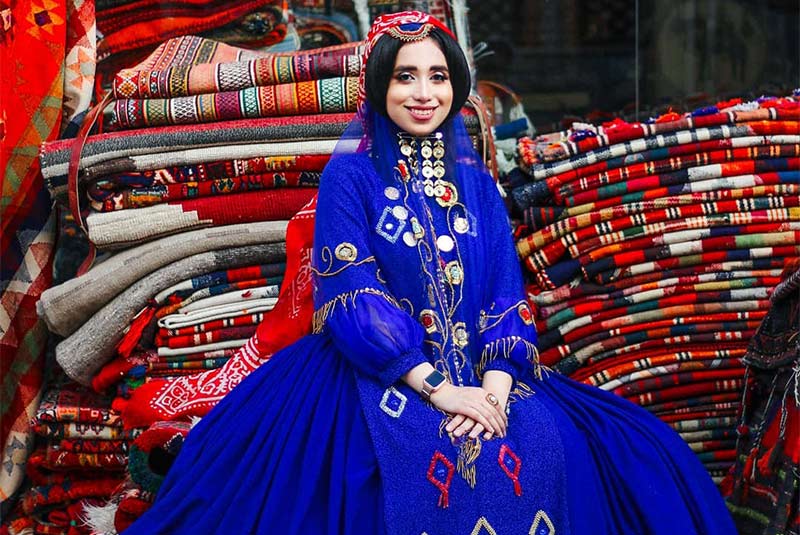
The Qashqai clan are a clan of nomadic tribespeople mainly of Kurdish, Turkic, and Arabic origins living in the Fars region. The most critical moral characteristics of the Qashqai people are simplicity, purity, happiness, vitality, perseverance, and courage, the effect of which can be seen in their dresses. So, most of their dresses are colourful and have unique and beautiful designs. The Qashqai women are far from the traditional, stay-at-home type. They actively participate in the same tasks as the men of their families. Their clothing has been designed to offer them freedom of movement per their many duties. They wear Arkhalig, which covers the body thoroughly from the shoulders to the ankles. This item of clothing has been slashed at the sides to make moving around easier.
They also wear Tunban, which is a ruffled skirt designed to cover the body even when a stiff wind threatens to unfold the dress, the women sometimes even wear two on top of one another to allow more coverage in addition to multiplying the beauty and grace of their movements. Charghad is a kind of scarf used to cover women's hair. Another piece, called Dastmal, is used to cover the Charghad, to keep the cold weather at bay, and symbolically, to protect the head and the brain, which are the most valuable parts of the body in Qashqai culture. They also wear a long scarf tied from the top of the forehead to the back of the head, and its name is Yaghliq.
The men wear a sheep wool hat called Kolah Do Gooshi or "two-eared" hats. Qashqai men also wear Arkhalig, but theirs only comes down to the knees, with a shawl fastened mid-waist. This shawl is up to six meters long and usually comes in colours such as white or brown. It helps with the spine's alignment in quick movements or when heavy-lifting in the event of migration. It is also used as a pocket for keeping money, cigarettes and pipes.
Chogheh is the last item of clothing worn by Qashqai men, which is worn on top of Arkhalig. Its purpose is to add to the beauty of Qashqai traditional garb.
4. Baloch Traditional Dress
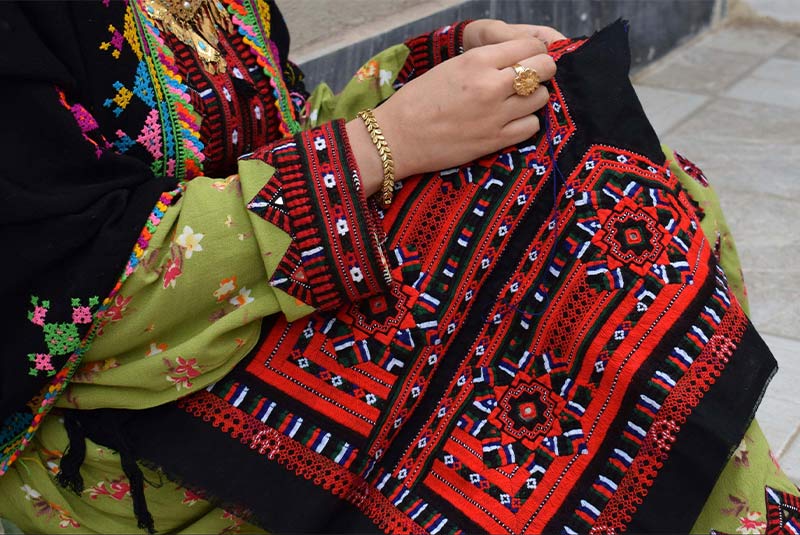
Baluch people belong to one of the oldest tribes in Iran, and their history dates back to more than 5000 B.C. So, it is the proper expectation that they should own one of Iran's best and most ancient culture and traditional clothing. Baloch traditional clothes give you a poetic feel because of their delicate needlework and long-standing art, which is displayed on their dresses on the sleeves, chest, and edges of the pants.
The designs of their clothes are exclusively geometric, arising from the combination of lines and shapes. The traditional clothing of Baloch people is simple and, at the same time, stunning and appropriate for the hot climate of Balochistan. Balooch men usually wear long shirts and baggy pants. They also wear a long white top piece as they live in a warm climate. And a turban is customary for men. Baloch women wear Jameg, something like a blouse, and a Pajameg, a colourful wide-legged pair of trousers. They also wear colourful embroidered knee-length dresses accompanied by a long scarf (Sarig) and Taku ( a veil) covering their head and shoulders. They also adorn themselves with lots of jewellery, such as earrings, necklaces, bangles, gold bracelets, and brooches.
5. Azari Traditional Dress
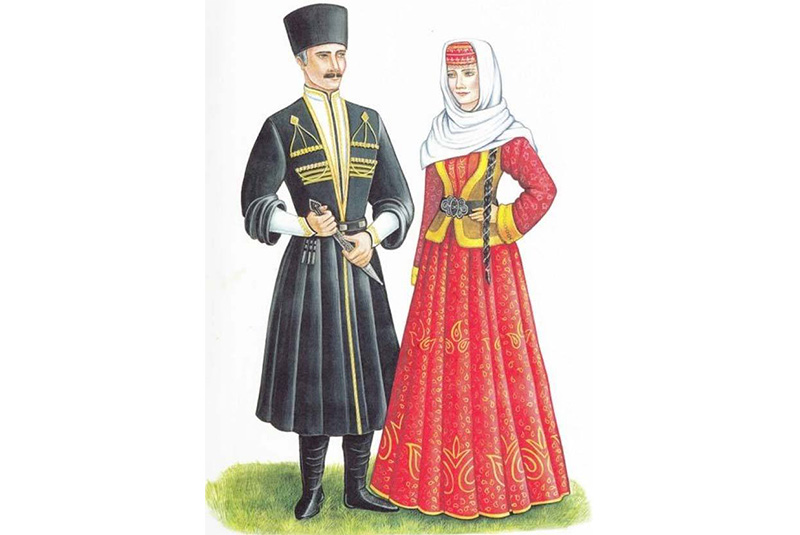
Azari is the second largest ethnic group in Iran. Although they are distributed throughout the whole country, Azari people mainly live in northern Iran along the border with Turkmenistan. In Azari culture and tradition, clothing tells a lot about Azari history and culture. It is also a means to show one's heritage and status in society and show off one's art and delicateness. Azari people can indicate a person's marital status and age from their dressing.
Azari young women wear long dresses in bright, cheerful colours and a small hat called Barak. Older married women wear headwear like a tiny hat called Yayliq under their long, colourful scarves. Some young women often conceal half of their face with a small piece of cloth hanging just below the nose. The men wear long coats with a hat made of wool to protect them against cold weather, as the place they live has a freezing climate.
6. Turkman Traditional Dress
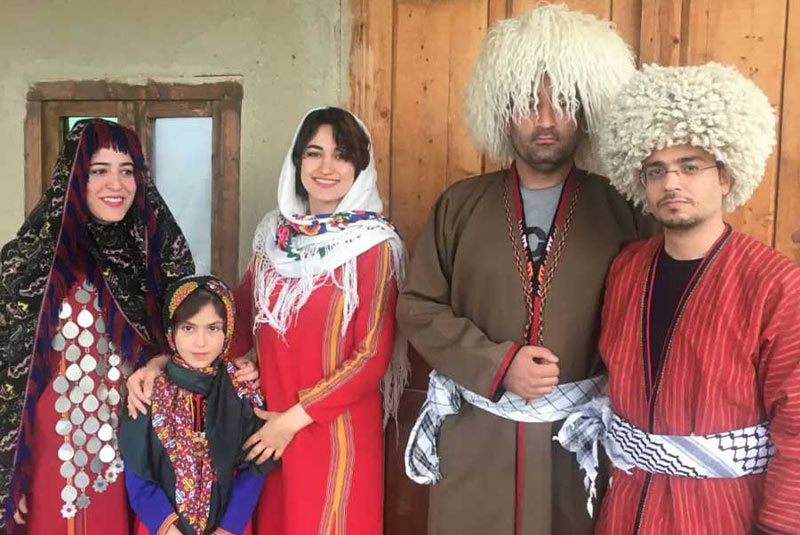
Iranian Turkmen are a branch of Turkmen living mainly in northern and northeastern Iran. Their traditional clothing is usually made of leather, silk, linen, and cotton. Turkman men's traditional clothing consists of hats, trousers, and shoes. They have two classic trousers, Balaq or Tonban, a loose cotton Tonban, and Jolbar, which older men wear at festivals. The women have different types of clothing that they wear on different occasions. They wear unique clothes at home and work clothes commonly used for agricultural work and baking bread. They also have city clothes for leaving the house and formal dresses for parties.
7. Lur Traditional Dress
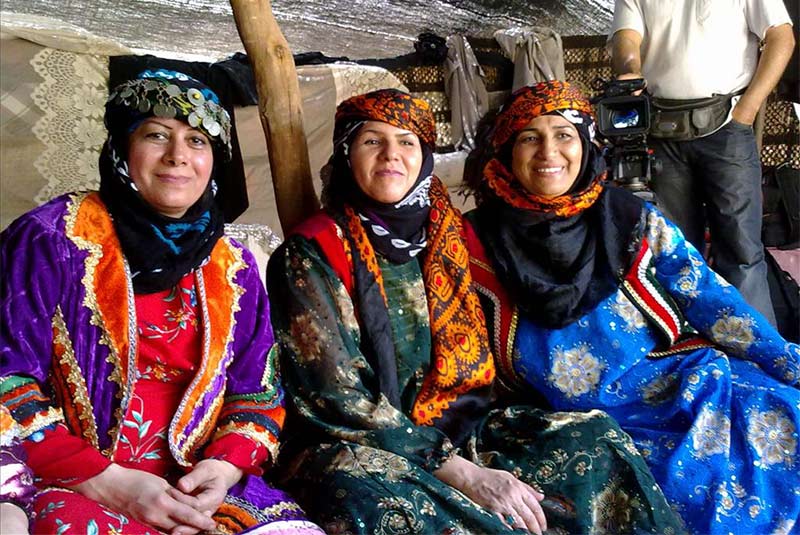
Luri belongs to Lorestan, Fars Province and Yasooj. The traditional Luri clothes are decorated with highly detailed beading and coins dangling from the headscarves, making them among the most eye-catching traditional dress in Iran. The Lur men wear neutral-coloured dresses, black hats and white Shaals wrapped around their waists. The Lur women lean towards bright colours; they wear colourful vests and long dresses with a headscarf around the head, neck and shoulders.
8. Khorasan Traditional Dress
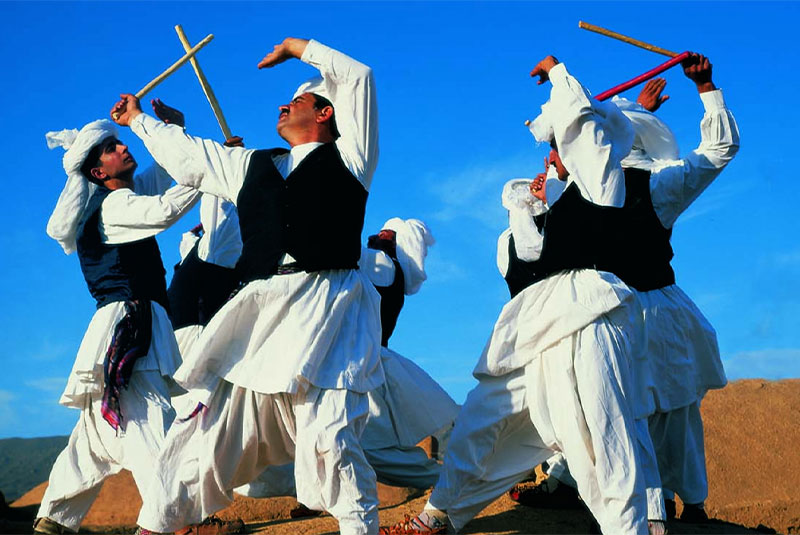
Khorasan is one of the central provinces of Iran located in the northeast. Khorasan is well known for its Saffron and Barberry. Khorasan traditional dress includes a scarf and a short wrinkled attire with colourful fabrics.
9. Gilak Traditional Dress

The people of Gilack call the north of Iran their home. They belong to northern Iran, including Rasht, Sari, Babolsar, Ramsar, Amol, etc. They live between the Alborz mountain on their south and the Caspian sea on their north. They get to live in one of the most flourishing and verdurous regions of Iran, which has primarily affected their way of clothing over time. Gilak tradition is mainly categorized into three sections: Taleshi in the west, Qasem-Abadi in the east, and Rosoukhi in the centre. The Gilak women wear floor-sweeping skirts decorated with colourful horizontal stripes. They also wear long pleated shirts layered with black velvet vests trimmed with bright embroidery and long scarves. Some women even wear a small hat that covers their foreheads and shoulders. They usually decorate their hat and vests with coins. They also wear colourful layered skirts with colourful stripes and coin decorations. The scarves, too, have unique imprints, usually of flowers and other decorations.
The men's wardrobe is more muted, with a black-and-white theme punctuated by a bright splash of colour in the socks or wide cotton waistband. They also wear loose trousers fastened around their waist with a shawl, a vest, and a woollen hat. The colour of the trousers, the vest and the hat are usually black; however, the colour of the shirt can vary depending on the personal taste of the man wearing it.
10. Bandar Abbas and Qeshm Traditional Dress

Bandar Abbas and Qeshm are in the southern region of Iran. The women prefer to choose very soft and thin cloth for their dresses. They wear colourfully coloured flowery chadors (a large piece of clothing covering the hair and upper body) and niqâb or face covering. They also wear lovely pants decorated with unique needlework showing their passion and talents. Another fantastic thing about the traditional clothing of the Hormozgan people is the 'Kondero', also used in Spain and southern Italy.


Comment
Leave a Comment